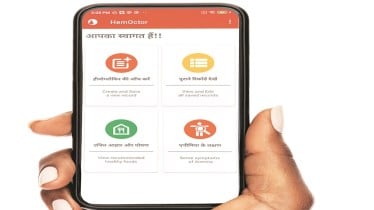AnAemia is a condition in which the blood doesn’t have enough healthy red blood cells. This leads to reduced oxygen flow to the body’s organs. Symptoms may include fatigue, shortness of breath, light-headedness, dizziness or a fast heartbeat. There are many different types of anaemia, but the most common type is iron-deficiency anaemia. As its name implies, iron-deficiency anaemia happens when your body doesn’t have enough iron to make hemoglobin. Haemoglobin is the substance in your red blood cells that enables them to carry oxygen throughout your body.
Anaemia is very common, affecting an estimated one-third of the global population. In India, as per the National Family Health Survey (2019-21), 57% of women and 25% of men (in the 15-49 group) have anaemia. Of course, you can cure anaemia by adding iron to your diet. However, how do you identify whether one is anaemic or not?
Traditionally, the doctor had to test a patient for anaemia through a blood test. With vastly improved health services, both invasive and smart anaemia-care techniques are used for its mass screening, however, significant drawbacks include high costs, lack of state-of-the-art facilities etc.
Also read: Diabetic care platform BeatO witnesses around 5x YoY user base growth from India’s tier 4 cities
Cut to present. Researchers at IIIT New Raipur have come up with the idea of an autonomous, smart anaemia-care technique to address these problems in the form of a spectroscopy-based blood hemoglobin level monitoring model.Two assistant professors from IIIT-NR — Debanjan Das and Venkanna U —have developed a mobile app, called sHEMO (Smartphone Spectroscopy for Blood Hemoglobin Level Monitoring in Smart Anaemia Care) that detects anaemia. The app screens the eye conjunctiva of the patient to detect whether the patient is anaemic or not.
Explaining the methodology, they said the screened image will proceed through machine learning, and the data will be compared with the earlier data embedded in the app, taken from AIIMS Raipur, and based on this, the app will come out with the result. “This is an Android app which is copyrighted under Indian Patent Office. We are also in the process of technology transfer,” the researchers informed FE.
“Our approach uses a smartphone camera as a sensor. The camera captures the eye image and based on the imaging spectroscopy, the app predicts the haemoglobin level. The predicted haemoglobin level is quantified similarly to the Gold Standard method of the haemoglobin measurement method. The patient will be classified as an anaemia patient or a non-anaemia patient. The camera has been tested and qualified for use. It is an
app-based screening programme which can even run on an ordinary smartphone; the user has to download it on their phone,” they added.
Also read: USFDA tentatively approves Lupin’s two HIV/AIDS tablets
SEEING THE SIGNS
*The phone’s camera captures an image of the eye conjunctiva and based on the imaging spectroscopy, the sHEMO app predicts the haemoglobin level
* Using machine learning, the data is compared with the embedded data taken from AIIMS Raipur, and anaemia is identified
* Developed by two IIIT-New Raipur assistant professors, the app has received a copyright from the Indian Patent Office
